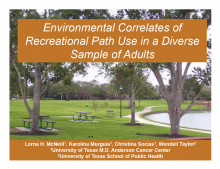We are pleased to announce an exciting new alliance between Active Living Research and GP RED to co-host and coordinate...
Environmental Correlates of Recreational Path Use in a Diverse Sample of Adults

Presentation at the 2010 Active Living Research Annual Conference
Background:
Recent research demonstrates the importance of the built environment as an important determinant of physical activity. People who have access to facilities and resources, such as parks and recreation paths, are more likely to engage in physical activity. Walking and bicycling are common activities performed on recreation paths, with walking being the most popular form of physical activity generally. Recreation paths have been noted for their potential for increasing physical activity in women, members of disadvantaged groups, and the sedentary. Therefore, communities with paths and individuals who use them are of great interest in order to better understand characteristics that facilitate usage. Few recreation path studies have included a diverse sample with adequate representation of racial & ethnic minority groups to understand their habits and patterns. As a result, we have limited information on characteristics of recreation paths that are important for these groups.
Objectives:
The objective of this pilot study was to survey path users from diverse racial/ethnic groups to examine their use of recreation paths and perceptions of environmental features that influence usage.
Methods:
The setting for this study is a recreation path was located in a master-planned community in a suburb of Houston, TX. In addition to recreation paths for walking, jogging, and biking, master-planned communities also have recreational amenities such as parks, lakes, tennis & basketball courts, and swimming pools. This was a short-term pilot, cross-sectional study, conducted over 6 weeks. Path users were intercepted or stopped while they were engaging in exercise and asked to complete a brief survey on their physical activity habits, path use, and perceptions of environmental features of the path. Participants had to be at least 18 years of age, walking on the recreation path, and be able to speak and write English or Spanish. Descriptive information about demographics, trail use and perceptions of environmental features are presented.
Results:
Path users (N=194) were majority female (56%) and affluent (70% with incomes $80k or greater). Users were diverse_29% white, 32% black, 21% Asian, and 11% Latino. Overall, 58% had been using the path for more than a year. Only 15% used the path daily; of these blacks used it most often at 21%. The majority used it 2-3 days per week (40%). Over 75% used the trail >30 minutes, with Latinos reporting the greatest amount of time spent on the trail (55% used it ≥ 45 minutes). Trail users most often used the trail with another person (53%); 25% used it alone and 10% used it with a pet. Compared to other racial/ethnic groups, Latinos were more likely to use the trail with someone else (75%), whites were more likely to use the trail most often with a pet (26%), and African Americans were more likely to use the trail alone (42%). Trail users reported several reasons for using the trail with the majority indicating that they used the trail for exercise (82%). Environmental features of the trail that users most enjoyed were that it is well-maintained and free of incivilities. However, users noted that more benches (38%) and water fountains were needed (46%).
Conclusion:
This study provides greater insight in an area of research where there has been limited information about recreation path use among racial/ethnic groups. Our findings suggest diversity in trail use among racial/ethnic groups; however, we are unable to determine statistical significance due to our small sample size. In particular, interesting findings that should be further explored include trail behavior of blacks and Latino groups, as this study demonstrates greater time on the trail than other racial/ethnic groups. This study also provides more information as to how diverse groups use and perceive environmental characteristics of recreation paths which could be used to encourage policy-makers to build recreation paths as an approach for increasing physical activity.
STAY UP TO DATE
RECENTLY ADDED TOOLS & RESOURCES
MOVE! A BLOG ABOUT ACTIVE LIVING
The "Active Living Conference" aims to break down research and practice silos and...







